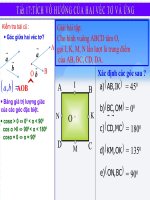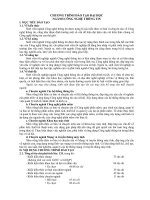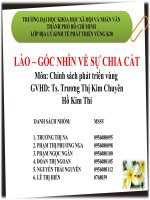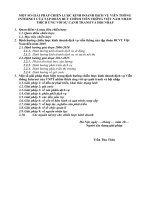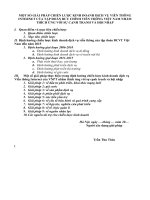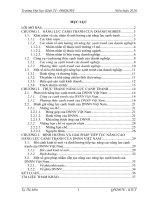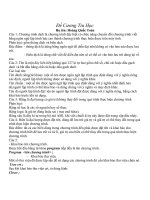AN0878 PIC18C ECAN ‘c’ routines
Bạn đang xem bản rút gọn của tài liệu. Xem và tải ngay bản đầy đủ của tài liệu tại đây (418 KB, 50 trang )
AN878
PIC18C ECAN ‘C’ Routines
Authors:
Caio Gübel and Nilesh Rajbharti
Microchip Technology, Inc.
INTRODUCTION
The Enhanced Controller Area Network (ECAN) module, offered by many of the PIC18F family of PICmicro®
microcontrollers, is the latest enhancement to the existing legacy CAN module. Devices such as the
PIC18C658/858 and PIC18F248/258/448/458 use the
legacy CAN module.
ECAN offers many enhancements over the legacy
CAN module in terms of more transmit/receive buffers,
acceptance filters, and hardware FIFO operation. At
the same time, the ECAN module is fully backward
compatible with the legacy CAN module.
ECAN provides three modes of operation – Mode 0,
Mode 1 and Mode 2. Mode 0 is fully backward compatible with the legacy CAN module. Applications developed for the legacy CAN module would continue to
work without any change using ECAN. Mode 1 is the
Enhanced Legacy mode with increased buffers and filters. Mode 2 has the same resources as Mode 1, but
with a hardware managed receive FIFO. Given its features and flexibility, ECAN would prove useful to many
CAN-based applications.
This application note implements ‘C’ routines to access
all features of the ECAN module. This document does
not describe ECAN and the related PIC18F family in
detail. Readers are encouraged to read the
PIC18F6585/6680/8585/8680 device data sheet
(DS30491) for more information.
2003 Microchip Technology Inc.
OVERVIEW OF ECAN MODULE
Following are the main features of the ECAN module:
• Fully backward compatible with the legacy CAN
module
• Three functional modes:
- Mode 0 – Fully backward compatible Legacy
mode
- Mode 1 – Enhanced Legacy mode
- Mode 2 – Hardware FIFO mode
• Implementation of these CAN protocols:
- CAN 1.2, CAN 2.0A and CAN 2.0B
• Standard and extended data frames
• Data length of 0-8 bytes
• Programmable bit rate up to 1 Mbps
• Support for automatic Remote Transmission
Request frame handling
• Dedicated double-buffered receiver with two
prioritized storage buffers
• Three dedicated transmit buffers with application
specified prioritization and abort capability
• Six full (Standard/Extended Identifier)
programmable receive/transmit buffers
• Sixteen full acceptance filters with dynamic
association to receive buffers
• Three full acceptance filter masks with dynamic
association to receive filters
• Programmable wake-up functionality with
integrated low-pass filter
• Programmable Loopback mode and
programmable state clocking supports self-test
operation
• Signaling via interrupt capabilities for all CAN
receiver and transmitter error codes
• Programmable clock source
• Programmable link-to-timer module for
time-stamping and network synchronization
• Low-power Sleep/Disable mode
• DeviceNet™ data byte filter support
• Advanced error management support features
DS00878A-page 1
AN878
Figure 1 shows a block diagram of the ECAN module
buffers and protocol engine.
BUFFERS
16-4 to 1 muxs
MESSAGE
MSGREQ
ABTF
MLOA
TXERR
MTXBUFF
MSGREQ
ABTF
MLOA
TXERR
MTXBUFF
TXB2
MESSAGE
TXB1
MESSAGE
MSGREQ
ABTF
MLOA
TXERR
MTXBUFF
TXB0
A
c
c
e
p
t
Acceptance Filters
(RXF0 – RXF05)
MODE 0
Acceptance Filters
(RXF06 – RXF15)
MODE 1, 2
MODE 0
2 RX
Buffers
Message
Queue
Control
Transmit Byte Sequencer
VCC
Acceptance Mask
RXM0
ECAN BUFFERS AND PROTOCOL ENGINE BLOCK DIAGRAM
Acceptance Mask
RXM1
FIGURE 1:
RXF15
Identifier
Data Field
M
A
B
Rcv Byte
MODE 1, 2
6 TX/RX
Buffers
Transmit Option
MESSAGE
BUFFERS
PROTOCOL
ENGINE
Receive
Error
Counter
Transmit<7:0>
Transmit
Error
Counter
Receive<8:0>
REC
TEC
Err-Pas
Bus-Off
Shift<14:0>
{Transmit<5:0>, Receive<8:0>}
Comparator
Protocol
Finite
State
Machine
CRC<14:0>
Transmit
Logic
Bit
Timing
Logic
Clock
Generator
TX
RX
Configuration
Registers
DS00878A-page 2
2003 Microchip Technology Inc.
AN878
OVERVIEW OF ECAN ROUTINES
• Out-of-the-box support for Microchip C18 and
Hi-Tech PICC 18™ C compilers
• Offers simple abstract interface to ECAN module
for most applications
• Additional functions/macros are available for
advanced applications
• Supports all three functional modes
• Provides access to all ECAN features in Polling
mode
- Easily modifiable to Interrupt Driven mode
• Operates in two main modes:
- Run-Time Library mode and Fixed Library
mode
• Various compile time options to customize
routines to a specific application
- Also available as the Microchip Application
Maestro™ module to simplify customization
ECAN FUNCTIONS ORGANIZATION
AND USAGE
These functions are developed for the Microchip C18
and Hi-Tech PICC 18 C compilers. ECAN routine source
files automatically detect the compiler in use and redefine corresponding symbols. If required, users can easily
port this file to any C compiler for PICmicro devices.
You may also create an object or library file for ECAN.c
and use the output file in your project, rather than using
the actual source code files.
The ECAN module offers various modes of operation
and configuration. Most of the applications will set
these configurations only once upon start. Given that
many of these configurations may not need to be
changed at run-time, ECAN routines provide a set of
compile-time options to configure the module at design
time. When compiled with the appropriate compile time
options set, ECAN routines will generate “customized”
code for your application. This approach results in
significantly less code than that generated entirely by
run-time routines.
It is anticipated that there may be cases where applications may need to change modes and configurations at
run-time depending on specific application conditions.
ECAN routines provide special compile time options
that allow applications to change all ECAN features at
run-time. When this mode is enabled, the resulting
code will be larger. The ECAN.def file contains all
available compile time options and their values.
FIGURE 2:
TYPICAL ECAN ROUTINES
USAGE
Start ECAN Module
Initialization
Source code for the ECAN routines is divided into the
following three files:
• ECAN.c
• ECAN.h
• ECAN.def
Even though ECAN functions provide a high level
interface to the ECAN module, users must be familiar
with the features and capabilities of the ECAN module.
This knowledge is absolutely required when setting up
compile time options in the ECAN.def file.
To employ these ECAN routines in your application,
perform the following steps:
1.
2.
3.
4.
Copy ECAN.c, ECAN.h and ECAN.def into
your application project directory.
Modify ECAN.def (compile time options) as per
your application requirements. You may manually
modify this file or use the Microchip Application
Maestro software. See Appendix A: “ECAN
Routines Compile Time Options” for more
information.
Include ECAN.c in your application project.
Add #include “ECAN.h” line in each source
file that will be calling ECAN routines. Make calls
to ECAN routines as required. See Appendix B:
“ECAN Functions” for the list of available
routines.
2003 Microchip Technology Inc.
Call
ECANInitialize
Function
End ECAN Module
Initialization
DS00878A-page 3
AN878
SAMPLE APPLICATION PROGRAM
USING ECAN ROUTINES
This application note includes the complete source
code for ECAN routines. In addition, it also includes the
sample application (ECANDemo.c) that demonstrates a
simple “echo” application using ECAN routines. There
are also two MPLAB® projects:
1.
2.
ECANDemo for Microchip C18 compiler.
ECANDemoHt for Hi-Tech PICC 18 compiler.
EXAMPLE 1:
SAMPLE APPLICATION – TYPICAL
#include “ecan.h”
void main(void)
{
unsigned long id;
BYTE data[4];
BYTE dataLen;
ECAN_RX_MSG_FLAGS flags;
// ECAN.def file must be set up correctly.
ECANInitialize();
while( !ECANSendMessage(0x123, data, 0, ECAN_TX_STD_FRAME) );
do
{
// Wait for a message to get received.
while( !ECANReceiveMessage(&id, data, &dataLen, &flags) );
// Increment received id and echo it back.
id++;
while( !ECANSendMessage(id, data, dataLen, flags) );
} while(1);
}
DS00878A-page 4
2003 Microchip Technology Inc.
AN878
EXAMPLE 2:
SAMPLE APPLICATION – ADVANCED
#include “ecan.h”
void RunTimeInitialization(void);
void main(void)
{
unsigned long id;
BYTE data[4];
BYTE dataLen;
ECAN_RX_MSG_FLAGS flags;
// Initialize ECAN as per compile-time options.
ECANInitialize();
// Receive and send messages. Upon receiving certain message
// change ECAN settings at run-time.
...
RunTimeInitialization();
// Continue with CAN communication
...
}
void RunTimeInitialization(void)
{
// Must be in Config mode to change many of settings.
ECANSetOperationMode(ECAN_OP_MODE_CONFIG);
// Select Mode 1
ECANSetFunctionalMode(ECAN_MODE_1);
// Make B0 as receiver.
ECANSetBnTxRxMode(B0, ECAN_BUFFER_RX);
// RXB0 will receive Standard messages only.
ECANSetRxBnRxMode(RXB0, ECAN_RECEIVE_ALL_VALID);
// B0 will receive Extended
ECANSetBnRxMode(B0, ECAN_RECEIVE_ALL_VALID);
// Link RXF0 to RXB0 and RXF1 to B0
ECANLinkRXF0F1ToBuffer(RXB0, B0);
ECANLinkRXF0Thru3ToMask(ECAN_RXM0,
ECAN_RXM1,
ECAN_RXM0,
ECAN_RXM0);
ECANSetRXF0Value(0,
ECANSetRXF1Value(0,
ECAN_MSG_STD);
ECAN_MSG_XTD);
ECANSetRXM0Value(0,
ECANSetRXM1Value(0,
ECAN_MSG_STD);
ECAN_MSG_XTD);
// Set 125kbps @ 25MHz
ECANSetBaudRate(2, 4, 8, 8, 8);
// Return to Normal mode to communicate.
ECANSetOperationMode(ECAN_OP_MODE_NORMAL);
}
2003 Microchip Technology Inc.
DS00878A-page 5
AN878
APPENDIX A:
TABLE A-1:
ECAN ROUTINES COMPILE TIME OPTIONS
ECAN.def COMPILE TIME OPTIONS
Option
Possible Values
Purpose
Note
ECAN_Bn_AUTORTR_MODE
(0 <= n <= 5)
ECAN_AUTORTR_MODE_DISABLE
ECAN_AUTORTR_MODE_ENABLE
Sets Buffer Bn in Automatic RTR Handling mode.
Mode 1,
Buffer Bn must be set up in Transmit mode using
Mode 2
ECAN_Bn_TXRX_MODE_VAL.
ECAN_AUTORTR_MODE_DISABLE disables
auto-RTR.
ECAN_AUTORTR_MODE_ENABLE enables auto-RTR.
ECAN_Bn_MODE_VAL
(0 <= n <= 5)
ECAN_RECEIVE_ALL_VALID
ECAN_RECEIVE_STANDARD
ECAN_RECEIVE_EXTENDED
ECAN_RECEIVE_ALL
Configures Bn Buffer Receive mode. This is used
only if Bn buffer is configured as receive buffer
using above option.
Meaning of values is same as
ECAN_RXB0_MODE_VAL.
Mode 1,
Mode 2
ECAN_Bn_TXRX_MODE_VAL
(0 <= n <= 5)
ECAN_BUFFER_TX
ECAN_BUFFER_RX
Configures buffer Bn as transmit or receive. There
are a total of five options – one for each
programmable buffer.
ECAN_BUFFER_TX selects transmit.
ECAN_BUFFER_RX selects receive.
Mode 1,
Mode 2
ECAN_BRP_VAL
1 through 8 inclusive
Sets baud rate prescale value.
ECAN_BUS_SAMPLE_MODE_VAL
ECAN_BUS_SAMPLE_MODE_THRICE
ECAN_BUS_SAMPLE_MODE_ONCE
Sets CAN bus Sample mode.
ECAN_BUS_SAMPLE_MODE_THRICE selects three
Sample modes.
ECAN_BUS_SAMPLE_MODE_ONCE selects one
Sample mode.
ECAN_CAPTURE_MODE_VAL
ECAN_CAPTURE_MODE_DISABLE
ECAN_CAPTURE_MODE_ENABLE
Sets CAN Capture mode. CCP1 must be
configured separately.
ECAN_CAPTURE_MODE_DISABLE disables CAN
Capture mode.
ECAN_CAPTURE_MODE_ENABLE enables CAN
Capture mode.
ECAN_FILTER_MODE_VAL
ECAN_FILTER_MODE_ENABLE
ECAN_FILTER_MODE_DISABLE
Select low-pass filter for CAN bus activity wake-up.
ECAN_FILTER_MODE_ENABLE selects wake-up
filter.
ECAN_FILTER_MODE_DISABLE deselects
wake-up filter.
ECAN_FUNC_MODE_VAL
ECAN_MODE_0
ECAN_MODE_1
ECAN_MODE_2
Sets initial functional mode for ECAN module.
ECAN_MODE_0 selects Mode 0.
ECAN_MODE_1 selects Mode 1.
ECAN_MODE_2 selects Mode 2.
ECAN_INIT_MODE
ECAN_INIT_NORMAL
ECAN_INIT_CONFIGURATION
ECAN_INIT_LOOPBACK
ECAN_INIT_DISABLE
ECAN_INIT_LISTEN_ONLY
Sets initial operational mode for ECAN module.
ECAN_INIT_NORMAL selects “normal” mode.
ECAN_INIT_CONFIGURATION selects
“Configuration” mode.
ECAN_INIT_LOOPBACK selects “Loopback” mode.
ECAN_INIT_DISABLE selects “Disable” or “Sleep”
mode.
ECAN_INIT_LISTEN_ONLY selects “Listen Only”
mode.
ECAN_LIB_MODE_VAL
ECAN_LIB_MODE_FIXED
ECAN_LIB_MODE_RUNTIME
Sets ECAN Routine Library mode.
ECAN_LIB_MODE_FIXED disables run-time
selection code.
ECAN_LIB_MODE_RUNTIME enables run-time
selection code.
ECAN_PHSEG1_VAL
1-8 inclusive
Sets Phase Segment 1 value.
ECAN_PHSEG2_MODE_VAL
ECAN_PHSEG2_MODE_PROGRAMMABLE Sets Phase Segment 2 Programming mode.
ECAN_PHSEG2_MODE_AUTOMATIC
ECAN_PHSEG2_MODE_PROGRAMMABLE sets Freely
Programmable mode.
ECAN_PHSEG2_MODE_AUTOMATIC allows ECAN
module to set it.
ECAN_PHSEG2_VAL
1-8 inclusive
Sets Phase Segment 2 value.
ECAN_PROPSEG_VAL
1-8 inclusive
Sets Propagation Segment value.
ECAN_RXB0_DBL_BUFFER_MODE_VAL ECAN_DBL_BUFFER_MODE_DISABLE Configures RXB0 in Hardware Double-Buffer mode. Mode 0
ECAN_DBL_BUFFER_MODE_ENABLE This is used in Mode 0 only.
ECAN_RXB0_MODE_VAL
DS00878A-page 6
ECAN_RECEIVE_ALL_VALID
ECAN_RECEIVE_STANDARD
ECAN_RECEIVE_EXTENDED
ECAN_RECEIVE_ALL
Sets RXB0 Buffer Receive mode.
ECAN_RECEIVE_ALL_VALID causes RXB0 to
receive all valid messages.
ECAN_RECEIVE_STANDARD causes RXB0 to
receive Standard messages.
ECAN_RECEIVE_EXTENDED causes RXB0 to
receive Extended messages.
ECAN_RECEIVE_ALL causes RXB0 to receive all
messages.
2003 Microchip Technology Inc.
AN878
TABLE A-1:
ECAN.def COMPILE TIME OPTIONS (CONTINUED)
Option
Possible Values
Purpose
Note
ECAN_RXB1_MODE_VAL
ECAN_RECEIVE_ALL_VALID
ECAN_RECEIVE_STANDARD
ECAN_RECEIVE_EXTENDED
ECAN_RECEIVE_ALL
Configures RXB1 Buffer Receive mode.
Meaning of values is same as
ECAN_RXB0_MODE_VAL.
ECAN_RXF0_MASK_VAL
ECAN_RXM0
ECAN_RXM1
ECAN_RXMF15
Links a filter to a specific mask register. If selected, Mode 1,
mask is ECAN_RXF15, RXF15 must not be linked to Mode 2
any buffer.
ECAN_RXM0 links to RXM0 mask.
ECAN_RXM1 links to RXM1 mask.
ECAN_RXMF15 links to RXF15 filter as mask.
ECAN_RXFn_BUFFER_VAL
RXB0
RXB1
B0
B1
B2
B3
B4
B5
Links a filter to a specific receive buffer. If selected, Mode 1,
buffer is a programmable buffer, it must be
Mode 2
configured as a receive buffer using
ECAN_Bn_TXRX_MODE.
RXBn links to one of the dedicated receive buffers.
Bn links to one of five programmable receive
buffers.
ECAN_RXFn_MODE_VAL
(0 <= n <= 15)
ECAN_RXFn_ENABLE
ECAN_RXFn_DISABLE
Enables/disables RXFn receive filters. In Mode 0,
Mode 1,
only RXF0-RXF5 are available and they are always Mode 2
enabled.
ECAN_RXFn_ENABLE enables corresponding RXFn
filter.
ECAN_RXFn_DISABLE disables corresponding
RXFn filter.
ECAN_RXFn_MSG_TYPE_VAL
(0 <= n <= 15)
ECAN_MSG_STD
ECAN_MSG_XTD
Sets Standard/Extended filter type. In Mode 0, only
RXF0-RXF5 are available.
ECAN_MSG_STD defines Standard filter type.
ECAN_MSG_XTD defines Extended filter type.
ECAN_RXFn_VAL
11-bit or 29-bit value as per filter type
Assigns 11 or 29-bit value to a filter. In Mode 0, only
RXF0-RXF5 are available.
ECAN_RXMn_MSG_TYPE
(0 <= n <= 1)
ECAN_MSG_STD
ECAN_MSG_XTD
Sets Standard/Extended mask type.
ECAN_MSG_STD defines Standard mask type.
ECAN_MSG_XTD defines Extended mask type.
ECAN_SJW_VAL
1-4 inclusive
Sets synchronization jump width value.
ECAN_TX2_MODE_VAL
ECAN_TX2_MODE_DISABLE
ECAN_TX2_MODE_ENABLE
Enables/disables CANTX2 pin.
ECAN_TX2_MODE_DISABLE disables CANTX2 pin.
ECAN_TX2_MODE_ENABLE enables CANTX2 pin.
ECAN_TX2_SOURCE_VAL
ECAN_TX2_SOURCE_COMP
ECAN_TX2_SOURCE_CLOCK
Sets CANTX2 signal source.
ECAN_TX2_SOURCE_COMP sets complement of
CANTX1 as source.
ECAN_TX2_SOURCE_CLOCK sets CAN block as
source.
ECAN_TXDRIVE_MODE_VAL
ECAN_TXDRIVE_MODE_TRISTATE
ECAN_TXDRIVE_MODE_VDD
Defines how CANTX1 pin will be driven in
Recessive mode.
ECAN_TXDRIVE_MODE_TRISTATE sets CANTX pin
in Tri-State mode.
ECAN_TXDRIVE_MODE_VDD sets CANTX pin in
VDD mode.
ECAN_WAKEUP_MODE_VAL
ECAN_WAKEUP_MODE_ENABLE
ECAN_WAKEUP_MODE_DISABLE
Sets CAN bus Activity mode.
ECAN_WAKEUP_MODE_ENABLE enables Wake-up
mode.
ECAN_WAKEUP_MODE_DISABLE disables Wake-up
mode.
2003 Microchip Technology Inc.
DS00878A-page 7
AN878
APPENDIX B:
ECAN FUNCTIONS
ECANAbortAll
This macro aborts all pending messages from the ECAN module. See the PIC18F6585/6680/8585/8680 data sheet
regarding message abortion.
Syntax
void ECANAbortAll(void)
Parameters
None
Return Values
None
Pre-condition
None
Side Effects
None
Remarks
Use ECANIsAllAborted to verify whether any messages are still pending or in progress.
Example: Usage of ECANAbortAll
...
ECANAbortAll();
...
DS00878A-page 8
2003 Microchip Technology Inc.
AN878
ECANDisableCANTX2
This macro sets the CANTX2 pin as a digital I/O.
Syntax
void ECANDisableCANTX2(void)
Parameters
None
Return Values
None
Pre-condition
None
Side Effects
None
Remarks
None
Example: Usage of ECANDisableCANTX2
// Configure CANTX2 pin as digital I/O pin.
ECANDisableCANTX2();
...
2003 Microchip Technology Inc.
DS00878A-page 9
AN878
ECANGetFilterHitInfo
This macro returns the number of the filter that caused the last message reception.
Syntax
BYTE ECANGetFilterHitInfo(void)
Parameters
None
Return Values
0 through 15: 0 means RXF0, 1 means RXF1 and so on.
Pre-condition
ECANReceiveMessage() was called and returned TRUE.
Side Effects
None
Remarks
This macro returns filter hit information that was stored by previous call to ECANReceiveMessage() function.
Example: Usage of ECANGetFilterHitInfo
// Use ECAN.def options to initialize ECAN module.
ECANInitialize();
...
while(1)
{
// Send a message.
if ( !ECANReceiveMessage(&myID,
&myData,
&dataLen,
&rxFlags) )
{
// There was no message waiting. Try again...
...
}
// A message is received.
// Find out which filter caused this acceptance.
filterNumber = ECANGetFilterHitInfo();
...
DS00878A-page 10
2003 Microchip Technology Inc.
AN878
ECANGetFunctionalMode
This macro returns the current ECAN functional mode.
Syntax
BYTE ECANGetFunctionalMode(void)
Parameters
None
Return Values
ECAN functional mode. Returned value will be one of following:
Value
Meaning
ECAN_MODE_0
Mode 0
ECAN_MODE_1
Mode 1
ECAN_MODE_2
Mode 2
Pre-condition
None
Side Effects
None
Remarks
None
Example: Usage of ECANGetFunctionalMode
// Set configuration mode.
ECANSetOperationMode(ECAN_OP_MODE_CONFIG);
// Now change functional mode
ECANSetFunctionalMode(ECAN_MODE_2);
...
// Check current functional mode
currentMode = ECANGetFunctionalMode();
if ( currentMode == ECAN_MODE_0 )
// in Mode 0
...
else if ( currentMode == ECAN_MODE_1 )
// in Mode 1
...
else
// in Mode 2
...
...
2003 Microchip Technology Inc.
DS00878A-page 11
AN878
ECANGetOperationMode
This macro gets the current ECAN module operation mode.
Syntax
ECAN_OP_MODE ECANGetOperationMode(void)
Parameters
None
Return Values
Value
Meaning
ECAN_OP_MODE_NORMAL
Specifies normal mode of operation
ECAN_OP_MODE_SLEEP
Specifies Sleep mode of operation
ECAN_OP_MODE_LOOP
Specifies Loopback mode of operation
ECAN_OP_MODE_LISTEN
Specifies Listen Only mode of operation
ECAN_OP_MODE_CONFIG
Specifies Configuration mode of operation
Pre-condition
None
Side Effects
None
Remarks
None
Example: Usage of ECANGetOperationMode
// Set configuration mode.
ECANSetOperationModeNoWait(ECAN_OP_MODE_CONFIG);
// Wait for mode to get accepted
while( ECANGetOperationMode() != ECAN_OP_MODE_CONFIG )
{
// Do something while mode is being accepted.
}
...
DS00878A-page 12
2003 Microchip Technology Inc.
AN878
ECANGetRxErrorCount
This macro returns the ECAN receive error count as defined by the BOSCH CAN Specification. See the PIC18F6585/
6680/8585/8680 data sheet for more information.
Syntax
BYTE ECANGetRxErrorCount(void)
Parameters
None
Return Values
Current value of receive error count.
Pre-condition
None
Side Effects
None
Remarks
None
Example: Usage of ECANGetRxErrorCount
BYTE rxErrorCount;
rxErrorCount = ECANGetRxErrorCount();
...
2003 Microchip Technology Inc.
DS00878A-page 13
AN878
ECANGetTxErrorCount
This macro returns the ECAN transmit error count as defined by the BOSCH CAN Specification. See the PIC18F6585/
6680/8585/8680 data sheet for more information.
Syntax
BYTE ECANGetTxErrorCount(void)
Parameters
None
Return Values
Current value of transmit error count.
Pre-condition
None
Side Effects
None
Remarks
None
Example: Usage of ECANGetTxErrorCount
BYTE txErrorCount;
txErrorCount = ECANGetTxErrorCount();
...
DS00878A-page 14
2003 Microchip Technology Inc.
AN878
ECANInitialize
This function initializes the ECAN module with the compile time options as defined in the ECAN.def file.
Syntax
void ECANInitialize()
Parameters
None
Return Values
None
Pre-condition
None
Side Effects
All pending CAN message transmissions are aborted.
Remarks
This function puts the ECAN module into Configuration mode and sets all bit rate, transmit/receive buffer, acceptance filter and mask registers. Values and type of initialization are determined by compile time options defined in
the ECAN.def file. Upon completion, the ECAN module is set to compile time defined operational mode. If the
application is ready to communicate on the CAN bus, the compile time option of normal mode should be selected.
Example: Usage of ECANInitialize
// Use ECAN.def options to initialize ECAN module.
ECANInitialize();
// ECAN module will be in operation mode as per ECAN_INIT_MODE
2003 Microchip Technology Inc.
DS00878A-page 15
AN878
ECANIsAllAborted
This macro returns the status of the previous ECANAbortAll request.
Syntax
BOOL ECANIsAllAborted(void)
Parameters
None
Return Values
TRUE: If there is no pending transmission.
FALSE: If abort is still in progress.
Pre-condition
None
Side Effects
None
Remarks
None
Example: Usage of ECANIsAllAborted
...
ECANAbortAll();
while( !ECANIsAllAborted() )
{
// Do something while abort is in progress…
}
...
DS00878A-page 16
2003 Microchip Technology Inc.
AN878
ECANIsBusOff
This macro returns the current ECAN bus on/off state.
Syntax
BOOL ECANIsBusOff(void)
Parameters
None
Return Values
TRUE: If the ECAN module is in the bus off state.
FALSE: If the ECAN module is not in bus off state.
Pre-condition
None
Side Effects
None
Remarks
None
Example: Usage of ECANIsBusOff
...
if ( ECANIsBusOff() )
// ECAN is Bus off
...
2003 Microchip Technology Inc.
DS00878A-page 17
AN878
ECANIsRxPassive
This macro returns the current ECAN receive error status as defined by the BOSCH CAN Specification. See the
PIC18F6585/6680/8585/8680 data sheet for more information.
Syntax
BOOL ECANIsRxPassive(void)
Parameters
None
Return Values
TRUE: If the ECAN module is in receive error passive state.
FALSE: If the ECAN module is not in receive error passive state.
Pre-condition
None
Side Effects
None
Remarks
None
Example: Usage of ECANIsRxPassive
...
if ( ECANIsRxPassive() )
// ECAN is in receive passive state
...
DS00878A-page 18
2003 Microchip Technology Inc.
AN878
ECANIsTxPassive
This macro returns the current ECAN transmit error status as defined by the BOSCH CAN Specification. See the
PIC18F6585/6680/8585/8680 data sheet for more information.
Syntax
BOOL ECANIsTxPassive(void)
Parameters
None
Return Values
TRUE: If the ECAN module is in transmit error passive state.
FALSE: If the ECAN module is not in transmit error passive state.
Pre-condition
None
Side Effects
None
Remarks
None
Example: Usage of ECANIsTxPassive
...
if ( ECANIsTxPassive() )
// ECAN is in transmit passive state
...
2003 Microchip Technology Inc.
DS00878A-page 19
AN878
ECANLinkRXFnFmToBuffer
This macro links filters to buffers. There are a total of eight macros. Each macro links two filters at a time.
ECANLinkRXF0F1ToBuffer links RXF0 and RXF1 filters to buffers. These macros are available in Mode 1 and
Mode 2 only.
Syntax
void
void
void
void
void
void
void
void
ECANLinkRXF0F1ToBuffer(RXF0Buffer, RXF1Buffer)
ECANLinkRXF2F3ToBuffer(RXF2Buffer, RXF3Buffer)
ECANLinkRXF4F5ToBuffer(RXF4Buffer, RXF5Buffer)
ECANLinkRXF6F7ToBuffer(RXF6Buffer, RXF7Buffer)
ECANLinkRXF8F9ToBuffer(RXF8Buffer, RXF9Buffer)
ECANLinkRXF10F11ToBuffer(RXF10Buffer, RXF11Buffer)
ECANLinkRXF12F13ToBuffer(RXF12Buffer, RXF13Buffer)
ECANLinkRXF14F15ToBuffer(RXF14Buffer, RXF15Buffer)
Parameters
RXFnBuffer
[in] Name of buffer that is to be linked to RXFn filter. The only permitted values are:
Value
Meaning
RXB0
Link to RXB0 buffer
RXB1
Link to RXB1 buffer
B0
Link to B0 buffer
B1
Link to B1 buffer
B2
Link to B2 buffer
B3
Link to B3 buffer
B4
Link to B4 buffer
B5
Link to B5 buffer
RXFmBuffer
[in] Name of buffer that is to be linked to RXFm filter. The only permitted values are:
Value
Meaning
RXB0
Link to RXB0 buffer
RXB1
Link to RXB1 buffer
B0
Link to B0 buffer
B1
Link to B1 buffer
B2
Link to B2 buffer
B3
Link to B3 buffer
B4
Link to B4 buffer
B5
Link to B5 buffer
Return Values
None
Pre-condition
(ECAN_LIB_MODE_VAL == ECAN_LIB_MODE_RUN_TIME)
or
(ECAN_FUNC_MODE_VAL != ECAN_MODE_0)
Side Effects
None
DS00878A-page 20
2003 Microchip Technology Inc.
AN878
ECANLinkRXFnFmToBuffer (Continued)
Remarks
Buffer value must be a constant of permitted values only. A variable parameter would cause a compile time error.
For example, ECANLinkRXF0F1ToBuffer(myRXF0Buffer, myRXF1Buffer) would not compile.
Example: Usage of ECANLinkRXFnFmToBuffer
// Link RXF0 to RXB0 and RXF1 to B3
ECANLinkRXF0F1ToBuffer(RXB0, B3);
// Link RXF6 and RXF7 to B2
ECANLinkRXF6F7ToBuffer(B2, B2);
...
2003 Microchip Technology Inc.
DS00878A-page 21
AN878
ECANLinkRXFnThrumToMask
This macro links filters to masks. There are a total of four macros. Each macro links four filters at a time.
ECANLinkRXF0Thru3ToMask links RXF0, RXF1, RXF2 and RXF3 filters to masks. These macros are available in
Mode 1 and Mode 2 only.
Syntax
void
void
void
void
ECANLinkRXF0Thru3ToMask(m0, m1, m2, m3)
ECANLinkRXF4Thru7ToMask(m4, m5, m6, m7)
ECANLinkRXF8Thru11ToMask(m8, m9, m10, m11)
ECANLinkRXF12Thru15ToMask(m12, m13, m14, m15)
Parameters
m
[in] Name of mask that is to be linked to RXFn filter. The only permitted values are:
Value
Meaning
ECAN_RXM0
Link to RXM0 mask
ECAN_RXM1
Link to RXM1 mask
ECAN_RXMF15
Link to RXF15 mask
Return Values
None
Pre-condition
(ECAN_LIB_MODE_VAL == ECAN_LIB_MODE_RUN_TIME)
or
(ECAN_FUNC_MODE_VAL != ECAN_MODE_0)
Side Effects
None
Remarks
These macros perform compile time operations to reduce generated code. If possible, always supply a constant
value of permitted type. A variable argument will result in larger code.
Example: Usage of ECANLinkRXFnThrumToMask
// Link RXF0 to RXM0, RXF1 to RXM0, RXF2 to RXM1 and RXF3 to RXM1
ECANLinkRXF0Thru3ToMask(ECAN_RXM0,
ECAN_RXM0,
ECAN_RXM1,
ECAN_RXM1);
...
DS00878A-page 22
2003 Microchip Technology Inc.
AN878
ECANLoadRTRBuffer
This function loads the given message to the specified buffer that is configured for automatic RTR handling. This
function is available in Mode 1 and Mode 2 only.
Syntax
BOOL ECANLoadRTRBuffer(BYTE buffer,
unsigned long id,
BYTE *data,
BYTE dataLen,
BYTE type)
Parameters
buffer
[in] Programmable buffer number that is to be loaded. The possible values are 0 through 5, inclusive. Use 0 for
B0, 1 for B1 and so on.
id
[in] 32-bit Identifier value which may correspond to right justified 11-bit Standard Identifier or 29-bit Extended
Identifier. The exact number of bits to use depends on type parameter.
data
[in] Pointer to zero or more data bytes to send.
dataLen
[in] Number of bytes to send.
type
[in] Specifies an enumerated value of the message type. The possible values of all variables are listed in the
following table:
Value
Meaning
ECAN_MSG_STD
Standard Message type
ECAN_MAS_XTD
Extended Message type
Return Values
TRUE: If the given message was loaded into the given buffer.
FALSE: If the given buffer was not set up for automatic RTR handling or is in the middle of automatic
transmission.
Pre-condition
buffer must be configured for automatic RTR handling.
Side Effects
None
Remarks
This function makes sure that the given buffer is not in the middle of auto-transmitting the RTR response. Since the
automatic RTR response may get transmitted at any time, even while the function is loading new data, this function
first starts by clearing the DLC byte. As a result, if the automatic RTR response is to start in the middle of the update,
it will result in a 0 byte long response. The remote node that made the RTR request must detect the 0 byte long
message as incomplete and issue another RTR.
2003 Microchip Technology Inc.
DS00878A-page 23
AN878
ECANLoadRTRBuffer (Continued)
Example: Usage of ECANLoadRTRBuffer
// Use ECAN.def options to initialize ECAN module.
// ECAN is set up in Mode 1 and B5 is configured as AutoRTR
ECANInitialize();
// B5 is not set up correctly to be AutoRTR buffer.
...
while(1)
{
// Perform regular logic
...
// At some point in time, we need to update RTR buffer
if ( !ECANLoadRTRBuffer(5, // Load B5 buffer
newData,
newDataLen,
ECAN_MSG_STD) )
{
// B5 buffer must be in middle of transmission
// Either try again or do it in next execution.
}
...
}
DS00878A-page 24
2003 Microchip Technology Inc.
AN878
ECANReceiveMessage
This function copies one of the full receive buffer messages into the given buffer and marks the full receive buffer as
empty.
Syntax
BOOL ECANReceiveMessage(unsigned long *id,
BYTE *data,
BYTE dataLen,
ECAN_RX_MSG_FLAGS *msgFlags)
Parameters
id
[out] 32-bit Identifier value which may correspond to right justified 11-bit Standard Identifier or 29-bit Extended
Identifier. The exact number of bits to use depends on msgFlags parameter.
data
[out] Pointer to zero or more data bytes to send.
dataLen
[out] Number of bytes to send.
msgFlags
[out] Specifies an enumerated value of the type ECAN_RX_MSG_FLAGS. This represents the logical OR of one or
more flags. The possible values of all variables are listed in the table below:
Value
Meaning
ECAN_RX_OVERFLOW
Specifies receive buffer overflow
ECAN_RX_INVALID_MSG
Specifies invalid message
ECAN_RX_XTD_FRAME
Specifies Extended Identifier message
ECAN_RX_STD_FRAME
Specifies Standard Identifier message
ECAN_RX_DBL_BUFFERED
Specifies that this message was double-buffered
If a flag bit is set, the corresponding meaning is TRUE; if cleared, the corresponding meaning is FALSE.
Return Values
TRUE: If new message was copied to the given buffer.
FALSE: If no new message was found.
Pre-condition
The id, data, dataLen and msgflags pointer must point to the desired and valid memory locations.
Side Effects
None
Remarks
This function will return FALSE if there are no new messages to read. Caller may check the return value to
determine new message availability. Additional information, such as which filter caused this reception, may be
determined by calling the ECANGetFilterHitInfo() macro.
2003 Microchip Technology Inc.
DS00878A-page 25
